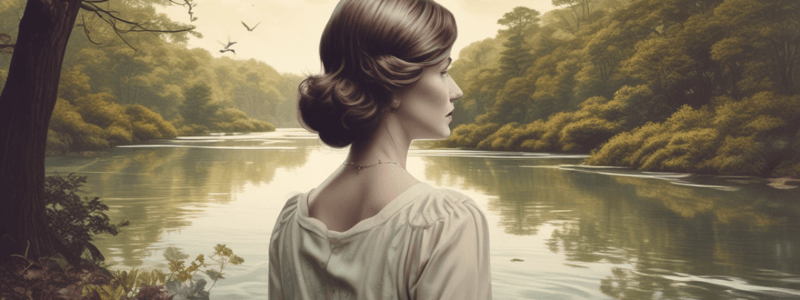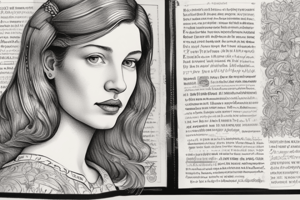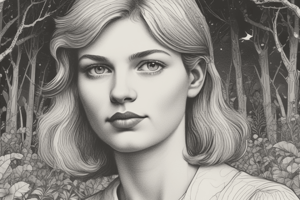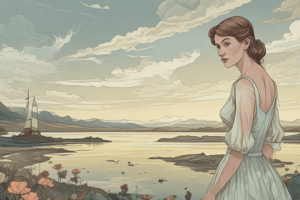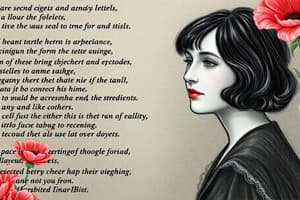Podcast
Questions and Answers
What is the primary theme presented in 'Black Rook in rainy weather'?
What is the primary theme presented in 'Black Rook in rainy weather'?
What is the structure of each stanza in the poem?
What is the structure of each stanza in the poem?
What literary device is used in the line 'Hunches a wet black rook'?
What literary device is used in the line 'Hunches a wet black rook'?
What is the tone of the speaker in the lines 'I do not expect a miracle / Or an accident'?
What is the tone of the speaker in the lines 'I do not expect a miracle / Or an accident'?
Signup and view all the answers
What is the effect of the use of commas in the lines 'Although, I admit, I desire, / Occasionally, some backtalk'?
What is the effect of the use of commas in the lines 'Although, I admit, I desire, / Occasionally, some backtalk'?
Signup and view all the answers
What literary device is used in the line 'Let spotted leaves fall as they fall / Without ceremony, or portent'?
What literary device is used in the line 'Let spotted leaves fall as they fall / Without ceremony, or portent'?
Signup and view all the answers
What is the significance of the 'mute sky' in the poem?
What is the significance of the 'mute sky' in the poem?
Signup and view all the answers
What is the effect of the use of sibilance in the line 'To set the sight on fire / In my eye, nor seek'?
What is the effect of the use of sibilance in the line 'To set the sight on fire / In my eye, nor seek'?
Signup and view all the answers
What does Plath convey through her tone in the poem 'Black Rook in Rainy Weather'?
What does Plath convey through her tone in the poem 'Black Rook in Rainy Weather'?
Signup and view all the answers
What does Plath describe as 'honor / one might say love'?
What does Plath describe as 'honor / one might say love'?
Signup and view all the answers
What does the phrase 'whatever angel' suggest about Plath's tone?
What does the phrase 'whatever angel' suggest about Plath's tone?
Signup and view all the answers
What does the sibilance in the phrase 'so shine / As to seize my senses' convey?
What does the sibilance in the phrase 'so shine / As to seize my senses' convey?
Signup and view all the answers
What is the 'enemy' Plath refers to in the poem?
What is the 'enemy' Plath refers to in the poem?
Signup and view all the answers
What does Plath use to describe the miracles in the poem?
What does Plath use to describe the miracles in the poem?
Signup and view all the answers
What is Plath waiting for in the final lines of the poem?
What is Plath waiting for in the final lines of the poem?
Signup and view all the answers
What does the poem 'Black Rook in Rainy Weather' primarily explore?
What does the poem 'Black Rook in Rainy Weather' primarily explore?
Signup and view all the answers
What does the 'brief respite from fear / of total neutrality' represent in the poem?
What does the 'brief respite from fear / of total neutrality' represent in the poem?
Signup and view all the answers
What does the poem suggest about the connection from the natural world?
What does the poem suggest about the connection from the natural world?
Signup and view all the answers
Study Notes
Poem Structure and Style
- The poem "Black Rook in Rainy Weather" consists of structured stanzas, each with five lines, except for the final line.
- The poem uses hidden rhymes, enjambment, and distinct caesurae to create a sense of pace and pause.
- The inclusion of sibilance and assonance adds a musical quality to the poem.
Themes and Ideas
- The poem explores the need for inspiration and the interplay between humanity and the natural world.
- The poem touches on the theme of divine power and the writer's process.
- The natural world has the capacity to inspire, but the speaker is aware of her fragile mental state.
Imagery and Symbolism
- The black rook is a symbol of the natural world and its ability to inspire.
- The use of pathetic fallacy creates a bleak and downtrodden mood.
- The speaker describes the black rook as "hunches" and "arranging and rearranging its feathers," conveying a sense of negativity.
Speaker's Tone and Perspective
- The speaker uses first-person narrative to introduce her thoughts and feelings.
- The speaker appears indifferent and unexpecting of inspiration from the natural world.
- The speaker desires inspiration, but is cautious not to place too much hope in it.
Connection with the Natural World
- The speaker describes the natural world as having the power to bestow "honor" or "love" upon her.
- The speaker longs for a connection with the natural world, but is aware of the possibility of disappointment.
- The poem suggests that inspiration can come from ordinary objects, making the mundane seem special.
Hope and Inspiration
- The poem expresses a desire for "a brief respite from fear of total neutrality."
- The speaker wishes to experience moments of inspiration, which are described as "miracles" or "tricks of radiance."
- The poem concludes with the speaker waiting for the "rare, random descent" of inspiration from the natural world.
Studying That Suits You
Use AI to generate personalized quizzes and flashcards to suit your learning preferences.
Description
Explore the themes, ideas, and literary style of Plath's poem 'Black Rook in Rainy Weather', which delves into her relationship with the world and its capacity to inspire.
